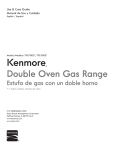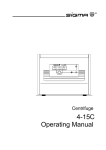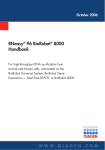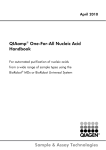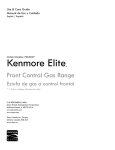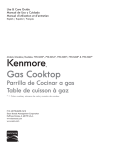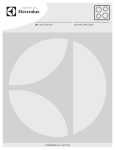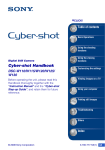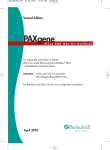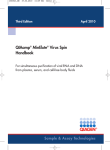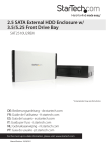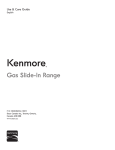Download QIAamp 96 DNA Swab BioRobot Kit Handbook
Transcript
1063033_HB 21.04.2010 19:34 Uhr SecondEdition Edition Fourth Seite 1 December April 2005 2010 QIAamp® 96 DNA Swab BioRobot® Kit Handbook For automated purification of genomic DNA from buccal swabs using the BioRobot Universal System, BioRobot Genotyping, or BioRobot 9604 Sample & Assay Technologies 1063033_HB 21.04.2010 19:34 Uhr Seite 2 QIAGEN Sample and Assay Technologies QIAGEN is the leading provider of innovative sample and assay technologies, enabling the isolation and detection of contents of any biological sample. Our advanced, high-quality products and services ensure success from sample to result. QIAGEN sets standards in: ■ Purification of DNA, RNA, and proteins ■ Nucleic acid and protein assays ■ microRNA research and RNAi ■ Automation of sample and assay technologies Our mission is to enable you to achieve outstanding success and breakthroughs. For more information, visit www.qiagen.com. QIAGEN is a member of the Forest Stewardship Council (FSC). For the production of printed materials, including handbooks, QIAGEN has a policy to select suppliers that comply with FSC standards for printing processes and well-managed forests. 1063033_HB 21.04.2010 19:34 Uhr Seite 3 Contents Kit Contents 4 Storage 4 Quality Control 5 Product Use Limitations 5 Product Warranty and Satisfaction Guarantee 5 Technical Assistance 6 Safety Information 6 Introduction Principle and procedure 8 8 Equipment and Reagents to Be Supplied by User 11 Important Notes 12 Sample processing 12 Preparation of reagents 12 Using plasticware on BioRobot systems 16 Setting up the BioRobot workstation 19 Centrifugation 24 Protocols Purification of Genomic DNA from Buccal Swabs on the BioRobot Universal System 25 Purification of Genomic DNA from Buccal Swabs on the BioRobot Genotyping 27 Purification of Genomic DNA from Buccal Swabs on the BioRobot 9604 29 Troubleshooting Guide 31 Appendix: Determination of Concentration, Yield, Purity, and Length of DNA 37 References 37 Ordering Information 38 QIAamp 96 DNA Swab BioRobot Kit Handbook 04/2010 3 1063033_HB 21.04.2010 19:34 Uhr Seite 4 Kit Contents QIAamp 96 DNA Swab BioRobot Kit (12) Catalog no. 965842 Number of preps 12 x 96 QIAamp 96 Plates 12 S-Blocks 14 Tape Pad 1 AirPore Tape Sheets Caps for Elution Microtubes Elution Microtubes CL 1 x 25 sheets 3 x 50 12 x 96 2 ml Tubes 50 Caps for 2 ml Tubes 50 15 ml Tubes for Buffer AL 48 250 ml Bottle for Buffer ATL Proteinase K 1 5 x 6 ml Buffer ATL 4 x 460 ml Buffer AL* 3 x 126 ml Buffer AW1* (concentrate) † Buffer AW2 (concentrate) 5 x 175 ml 10 x 127 ml Buffer AE 48 x 5 ml Handbook 1 * Contains a guanidine salt. Not compatible with disinfectants containing bleach. See page 6 for safety information. † Contains sodium azide as a preservative. Storage All components of the QIAamp 96 DNA Swab BioRobot Kit can be stored dry at room temperature (15–25°C) for up to 1 year. The QIAamp 96 DNA Swab BioRobot Kit contains a proteinase K solution that can be stored at room temperature (15–25°C). To store for extended periods of time, we recommend keeping the proteinase K at 2–8°C. 4 QIAamp 96 DNA Swab BioRobot Kit Handbook 04/2010 1063033_HB 21.04.2010 19:34 Uhr Seite 5 Quality Control In accordance with QIAGEN’s ISO-certified Quality Management System, each lot of QIAamp 96 DNA Swab BioRobot Kits is tested against predetermined specifications to ensure consistent product quality. Product Use Limitations The QIAamp 96 DNA Swab BioRobot Kit is intended for molecular biology applications. This product is not intended for the diagnosis, prevention, or treatment of a disease. All due care and attention should be exercised in the handling of the products. We recommend all users of QIAGEN products to adhere to the NIH guidelines that have been developed for recombinant DNA experiments, or to other applicable guidelines. Product Warranty and Satisfaction Guarantee QIAGEN guarantees the performance of all products in the manner described in our product literature. The purchaser must determine the suitability of the product for its particular use. Should any product fail to perform satisfactorily due to any reason other than misuse, QIAGEN will replace it free of charge or refund the purchase price. We reserve the right to change, alter, or modify any product to enhance its performance and design. If a QIAGEN product does not meet your expectations, simply call your local Technical Service Department or distributor. We will credit your account or exchange the product — as you wish. Separate conditions apply to QIAGEN scientific instruments, service products, and to products shipped on dry ice. Please inquire for more information. A copy of QIAGEN terms and conditions can be obtained on request, and is also provided on the back of our invoices. If you have questions about product specifications or performance, please call QIAGEN Technical Services or your local distributor (see back cover). QIAamp 96 DNA Swab BioRobot Kit Handbook 04/2010 5 1063033_HB 21.04.2010 19:34 Uhr Seite 6 Technical Assistance At QIAGEN, we pride ourselves on the quality and availability of our technical support. Our Technical Service Departments are staffed by experienced scientists with extensive practical and theoretical expertise in sample and assay technologies and the use of QIAGEN products. If you have any questions or experience any difficulties regarding the QIAamp 96 DNA Swab BioRobot Kit or QIAGEN products in general, please do not hesitate to contact us. QIAGEN customers are a major source of information regarding advanced or specialized uses of our products. This information is helpful to other scientists as well as to the researchers at QIAGEN. We therefore encourage you to contact us if you have any suggestions about product performance or new applications and techniques. For technical assistance and more information, please see our Technical Support Center at www.qiagen.com/Support or call one of the QIAGEN Technical Service Departments or local distributors (see back cover or visit www.qiagen.com ). Safety Information When working with chemicals, always wear a suitable lab coat, disposable gloves, and protective goggles. For more information, please consult the appropriate material safety data sheets (MSDSs). These are available online in convenient and compact PDF format at www.qiagen.com/Support/MSDS.aspx where you can find, view, and print the MSDS for each QIAGEN kit and kit component. CAUTION: DO NOT add bleach or acidic solutions directly to waste containing Buffer AL or Buffer AW1. Buffer AL and Buffer AW1 contain guanidine hydrochloride, which can form highly reactive compounds when combined with bleach. If liquid containing these buffers is spilt, clean with suitable laboratory detergent and water. If the spilt liquid contains potentially infectious agents, clean the affected area first with laboratory detergent and water, and then with 1% (v/v) sodium hypochlorite. 6 QIAamp 96 DNA Swab BioRobot Kit Handbook 04/2010 1063033_HB 21.04.2010 19:34 Uhr Seite 7 The following risk and safety phrases apply to components of the QIAamp 96 DNA Swab BioRobot Kit. Buffers AL and AW1 Contain guanidine hydrochloride: harmful, irritant. Risk and safety phrases:* R22-36/38, S13-26-36-46 Proteinase K Contains proteinase K: sensitizer, R36/37/38-42/43, S23-24-26-36/37 irritant. Risk and safety phrases:* 24-hour emergency information Emergency medical information in English, French, and German can be obtained 24 hours a day from: Poison Information Center Mainz, Germany Tel: +49-6131-19240 * R22: Harmful if swallowed; R36/38: Irritating to eyes and skin; R36/37/38: Irritating to eyes, respiratory system, and skin; R42/43: May cause sensitization by inhalation and skin contact; S13: Keep away from food, drink, and animal feedingstuffs; S23: Do not breathe spray; S24: Avoid contact with skin; S26: In case of contact with eyes, rinse immediately with plenty of water and seek medical advice; S36: Wear suitable protective clothing; S36/37: Wear suitable protective clothing and gloves; S46: If swallowed, seek medical advice immediately and show container or label. QIAamp 96 DNA Swab BioRobot Kit Handbook 04/2010 7 1063033_HB 21.04.2010 19:34 Uhr Seite 8 Introduction The QIAamp 96 DNA Swab BioRobot Kit enables automated purification of genomic DNA from up to 192 buccal swab samples on the BioRobot Universal System or BioRobot Genotyping, or from up to 96 buccal swabs on the BioRobot 9604. The kit combines the selective binding properties of a silica membrane with a high-throughput 96-well format. The procedure is suitable for use with air-dried buccal swabs with cotton or Dacron® tips, and brushes or swabs with an ejectable head (e.g., Whatman® Omni Swab). Other swab types may also be used. High-quality DNA that is free of protein, nucleases, and other contaminants or inhibitors is eluted in Buffer AE or water. DNA purified using the QIAamp 96 DNA Swab BioRobot Kit is up to 50 kb in size, with fragments of 20–30 kb predominating. Purified DNA is suitable for direct use in downstream applications, such as amplification or Southern blotting. Principle and procedure Lysis with proteinase K Dried cells attached to swab material are lysed under denaturing conditions at elevated temperatures. Lysis is performed in the presence of proteinase K and Buffer ATL. Addition of Buffer AL enhances lysis efficiency. Adsorption to QIAamp 96 silica membranes Binding conditions are adjusted by adding ethanol to the lysates to ensure optimal binding of DNA to the QIAamp 96 membrane. Lysates are applied to the QIAamp 96 plate, and DNA is adsorbed onto the silica membrane as the lysate is drawn through by vacuum pressure. Two different wash buffers are used followed by a wash step with ethanol, which increases the purity of the eluted DNA. Salt and pH conditions ensure that proteins and other contaminants, which can inhibit PCR and other downstream enzymatic reactions, are not retained on the QIAamp 96 membrane. With the BioRobot Universal System and BioRobot Genotyping, highly pure DNA is eluted under vacuum in a single step in 150 µl Buffer AE. Recovery is enhanced by overlaying with Top Elute Fluid. The DNA yield from a buccal swab is typically 0.5–2 µg. With the BioRobot 9604, high-quality DNA is eluted by a single centrifugation step. Genomic DNA can be conveniently stored for years and transported at room temperature in QIAsafe™ DNA Tubes and 96-Well Plates (see page 39 for ordering information). 8 QIAamp 96 DNA Swab BioRobot Kit Handbook 04/2010 1063033_HB 21.04.2010 19:34 Uhr Seite 9 QIAamp 96 DNA Swab BioRobot Procedure Using the BioRobot Universal System or BioRobot Genotyping Check volumes of reagents Scan bar codes of elution microtubes and S-Block containing samples Swabs collected in S-Block Lysis in proteinase K and preheated Buffer ATL (shaking) Simultaneously transfer lysates, ethanol, and Buffer AL Wash with Buffer AW1, and 2x wash with Buffer AW2 Vacuum Wash with ethanol Vacuum Dry QIAamp 96 plate Vacuum Add Buffer AE and Top Elute Fluid for elution Vacuum Pure genomic DNA QIAamp 96 DNA Swab BioRobot Kit Handbook 04/2010 9 1063033_HB 21.04.2010 19:34 Uhr Seite 10 QIAamp 96 DNA Swab BioRobot Procedure Using the BioRobot 9604 Add hot Buffer ATL and proteinase K Shake samples Scan bar codes Transfer lysate, and add Buffer AL Add ethanol Transfer lysate Overlay with Buffer AW1 Vacuum Wash with Buffer AW1 Vacuum Wash with Buffer AW2 Wash again with Buffer AW2 Centrifuge Add Buffer AE Centrifuge Pure genomic DNA 10 QIAamp 96 DNA Swab BioRobot Kit Handbook 04/2010 1063033_HB 21.04.2010 19:34 Uhr Seite 11 Equipment and Reagents to Be Supplied by User When working with chemicals, always wear a suitable lab coat, disposable gloves, and protective goggles. For more information, consult the appropriate material safety data sheets (MSDSs), available from the product supplier. For all protocols Swabs, such as sterile Omni Swabs (available from Whatman, www.whatman.com ) or Puritan® applicators with plastic shafts and cotton or Dacron tips (available from Hardwood Products, www.hwppuritan.com )* QIAGEN conducting disposable filter-tips, 1100 µl, (960), cat. no. 9012598 Ethanol (96–100%)† Deionized water For the BioRobot Universal System protocol BioRobot Universal System, cat. no. 9001094 Application Pack, Genotyping, cat. no. 9016755 Top Elute Fluid (48 x 1.48 ml), cat. no. 1020460 Disposable Troughs, 80 ml (10), cat. no. 9013653 2 ml Safe-Lock tubes cat. no. 0030 120.094) (e.g., Eppendorf® Safe-Lock micro test tubes, For the BioRobot Genotyping protocol BioRobot Genotyping‡ Top Elute Fluid (48 x 1.48 ml), cat. no. 1020460 Disposable Troughs, 20 ml (10), cat. no. 9232764 For the BioRobot 9604 protocol BioRobot 9604, configuration B§ 14 ml round-bottomed tubes (e.g., BD Falcon™ Round Bottom Polypropylene Tubes, 14 ml, cat. no. 352018; see www.bdbiosciences.com )* Centrifuge 4-16 or 4-16K with Plate Rotor 2 x 96 (see pages 39–40 for ordering information) * This is not a complete list of suppliers and does not include many important vendors of biological supplies. † Do not use denatured alcohol, which contains other substances such as methanol or methylethylketone. ‡ The BioRobot Genotyping has been discontinued. § The BioRobot 9604 has been discontinued. QIAamp 96 DNA Swab BioRobot Kit Handbook 04/2010 11 1063033_HB 21.04.2010 19:34 Uhr Seite 12 Important Notes Sample processing BioRobot Universal System and BioRobot Genotyping The BioRobot Universal System and BioRobot Genotyping are capable of processing swabs in S-Blocks. Heads of individual swabs with ejectable heads are ejected into one well of the S-Block. Shafts of swabs with non-ejectable heads should be cut so that the overall length of the swab is 50–65 mm. Longer or shorter swabs may cause movement errors during dispensing and aspiration of liquids and during bar code reading of the S-Block(s). BioRobot 9604 The BioRobot 9604 is capable of processing swabs in tubes of various sizes, such as 14 ml round-bottomed tubes. It is important to use round-bottomed sample tubes with a large diameter, so that the swabs can move freely (see Figure 1). Tubes with conical bottoms are not suitable because they restrict the movement of the swabs. Correct Insertion of Swabs in Sample Tubes Figure 1 Swabs should be placed in round-bottomed tubes, and if the shaft of the swab protrudes over the top of the tube, it should be snapped off at the level of the tube top to avoid contact with the robotic arm. Tubes with conical bottoms should not be used as swabs cannot move freely in them. For the same reason, swab shafts should not be broken off so short that the swabs can wedge in the bottom of the tubes. Preparation of reagents All reagent volumes supplied in the QIAamp 96 DNA Swab BioRobot Kit are sufficient for purification of genomic DNA in 12 runs of 96 samples. In addition, 4 tubes of Top Elute Fluid are required per run when using the BioRobot Universal System or BioRobot Genotyping, see “Equipment and Reagents to Be Supplied by User”, page 11. If several runs of fewer than 96 samples are performed, additional reagents must be purchased (see ordering information, page 38). 12 QIAamp 96 DNA Swab BioRobot Kit Handbook 04/2010 1063033_HB 21.04.2010 19:34 Uhr Seite 13 Proteinase K Proteinase K solution should be stored at room temperature (15–25°C). To store for extended periods of time, we recommend keeping the proteinase K at 2–8°C. Note: After the run, some diluted proteinase K may be left in the 2 ml tubes. Keep the remaining proteinase K for use during the next run. Leftover proteinase K can be stored at 4°C for up to 3 months. BioRobot Universal System: 1 volume of proteinase K must be diluted with 1.15 volumes of distilled water before use. The exact volume of diluted proteinase K needed depends on the number of samples per run and is calculated by the QIAsoft software. For example, for one run of 96 samples, four 2 ml tubes are needed, each containing 1.3 ml diluted proteinase K (700 µl distilled water and 600 µl proteinase K). Close the tubes and mix by pulse-vortexing for 15 seconds Centrifuge briefly to remove drops from the insides of the caps. BioRobot Genotyping: 1 volume of proteinase K must be diluted with 0.6 volumes of distilled water before use. The exact volume of diluted proteinase K needed depends on the number of samples per run and is calculated by the QIAsoft software. For example, for one run of 96 samples, four 2 ml tubes are needed, each containing 1.4 ml diluted proteinase K (525 µl distilled water and 875 µl proteinase K). Close the tubes and mix by pulse-vortexing for 15 seconds Centrifuge briefly to remove drops from the insides of the caps. BioRobot 9604: For one run of 96 samples, four 2 ml tubes are needed, each containing 1.3 ml diluted proteinase K (700 µl distilled water and 600 µl proteinase K). Close the tubes and mix by pulse-vortexing for 15 seconds Centrifuge briefly to remove drops from the insides of the caps. The same amount of diluted proteinase K should be prepared even if fewer than 96 samples are to be processed in a run. Buffer AL Buffer AL is supplied as a single reagent in a stock bottle (store at 15–25°C). Mix before use by shaking the bottle carefully, avoiding extensive foaming. Unused portions of Buffer AL can be stored at room temperature for use in the next run. BioRobot Universal System: The QIAsoft software indicates how much Buffer AL is required during setup of the BioRobot workstation before a run is started. The indicated volume of Buffer AL should be transferred into a disposable trough. Remove any large bubbles with a pipet tip. BioRobot Genotyping: The QIAsoft software indicates how much Buffer AL is required during setup of the BioRobot workstation before a run is started. The indicated volume of Buffer AL should be transferred into one disposable trough for a run of 96 samples and into two disposable troughs for a run of 192 samples. Remove any large bubbles with a pipet tip. QIAamp 96 DNA Swab BioRobot Kit Handbook 04/2010 13 1063033_HB 21.04.2010 19:34 Uhr Seite 14 BioRobot 9604: Before starting a run, 7.5 ml Buffer AL is distributed into each of four 15 ml tubes for Buffer AL. Do not fill more than the required number of tubes. The same volumes of Buffer AL should be dispensed even if fewer than 96 samples are processed per run. Ethanol BioRobot Universal System: Before starting a run, reconstituted Buffer AW2 must be added to the bottle containing ethanol (1:1000 dilution), to allow the BioRobot system to detect the fill level in the ethanol bottle by conductivity measurements. The QIAsoft software indicates how much ethanol is required during setup of the BioRobot workstation before a run is started. BioRobot Genotyping: Before starting a run, fill the empty 500 ml bottle for ethanol (supplied with the BioRobot Genotyping) with ethanol. Add 500 µl reconstituted Buffer AW2 to the bottle containing ethanol (1:1000 dilution), to allow the BioRobot system to detect the fill level in the ethanol bottle by conductivity measurements. Ethanol left over after a run should be stored at room temperature (15–25°C) in a closed bottle for the next run. BioRobot 9604: Before starting a run, fill the empty 500 ml bottle for ethanol (supplied with the BioRobot system) with 180 ml ethanol. Ethanol left over after a run should be stored at room temperature (15–25°C) in a closed bottle for the next run. Buffer ATL (black label) Unused portions of Buffer ATL can be stored at room temperature (15–25°C) for use in the next run. One bottle of Buffer ATL contains sufficient buffer for three runs of 96 samples. However, the following volumes of Buffer ATL are used to flush the system tubing of the BioRobot workstation during each run: approximately 30 ml for the BioRobot Universal System; approximately 30 ml for the BioRobot Genotyping; approximately 100 ml for the BioRobot 9604. Processing 96 samples over more than one run (e.g., two 48-sample runs) will therefore require more buffer than a single 96-sample run. If several runs of fewer than 96 samples are performed, additional Buffer ATL must be purchased (see ordering information, page 38). BioRobot Universal System: The QIAsoft software indicates how much Buffer ATL is required during setup of the BioRobot workstation before a run is started. BioRobot Genotyping: The QIAsoft software indicates how much Buffer ATL is required during setup of the BioRobot workstation before a run is started. BioRobot 9604: Before starting a run, fill the empty 250 ml bottle for Buffer ATL with 200 ml Buffer ATL. 14 QIAamp 96 DNA Swab BioRobot Kit Handbook 04/2010 1063033_HB 21.04.2010 19:34 Uhr Seite 15 Buffer AW1 (green label) Add 230 ml of ethanol (96–100%) to a bottle of Buffer AW1 concentrate, as described on the bottle. For easy identification, the Buffer AW1 bottle has a green label. Unused portions of reconstituted Buffer AW1 should be stored at room temperature (15–25°C) for use in the next run. Buffer AW1 is stable for 1 year when stored at room temperature. One bottle of Buffer AW1 contains sufficient wash buffer for more than two runs of 96 samples. However, the following volumes of Buffer AW1 are used to flush the system tubing of the BioRobot workstation during each run: approximately 30 ml for the BioRobot Universal System; approximately 30 ml for the BioRobot Genotyping; approximately 100 ml for the BioRobot 9604. Processing 96 samples over more than one run (e.g., two 48-sample runs) will therefore require more buffer than a single 96-sample run. If runs of fewer than 96 samples are performed, it may be necessary to purchase additional Buffer AW1 (see ordering information, page 38). Note: Always mix Buffer AW1 by shaking the bottle before starting the procedure. BioRobot Universal System: The QIAsoft software indicates how much Buffer AW1 is required during setup of the BioRobot workstation before a run is started. BioRobot Genotyping: The QIAsoft software indicates how much Buffer AW1 is required during setup of the BioRobot workstation before a run is started. BioRobot 9604: One run of 96 samples requires 200 ml of reconstituted Buffer AW1. Buffer AW2 (red label) Add 300 ml of ethanol (96–100%) to a bottle containing 127 ml of Buffer AW2 concentrate (provided), as described on the bottle. For easy identification, the Buffer AW2 bottle has a red label. Unused portions of reconstituted Buffer AW2 should be stored at room temperature (15–25°C) for use in the next run. Buffer AW2 is stable for 1 year when stored at room temperature. One bottle of Buffer AW2 contains sufficient wash buffer for more than one run of 96 samples. However, the following volumes of Buffer AW2 are used to flush the system tubing of the BioRobot workstation during each run: approximately 30 ml for the BioRobot Universal System; approximately 30 ml for the BioRobot Genotyping; approximately 100 ml for the BioRobot 9604. Processing 96 samples over more than one run (e.g., two 48-sample runs) will therefore require more buffer than a single 96-sample run. If runs of fewer than 96 samples are performed, it may be necessary to purchase additional Buffer AW2 (see ordering information, page 38). Note: Always mix Buffer AW2 by shaking the bottle before starting the procedure. QIAamp 96 DNA Swab BioRobot Kit Handbook 04/2010 15 1063033_HB 21.04.2010 19:34 Uhr Seite 16 BioRobot Universal System: The QIAsoft software indicates how much Buffer AW2 is required during setup of the BioRobot workstation before a run is started. BioRobot Genotyping: The QIAsoft software indicates how much Buffer AW2 is required during setup of the BioRobot workstation before a run is started. BioRobot 9604: One run of 96 samples requires 310 ml of reconstituted Buffer AW2. Buffer AE Buffer AE is supplied in aliquots of 5 ml. If less than 5 ml Buffer AE is required, store the unused portion of Buffer AE at room temperature (15–25°C) for use in the next run. Buffer AE can be replaced by water. BioRobot Universal System and BioRobot Genotyping: The volume required per run is calculated by the QIAsoft software, based on the number of samples. BioRobot 9604: Four tubes, each containing 5 ml Buffer AE, are required for each run of 96 samples. If fewer than 96 samples are to be processed, store the unused portion of Buffer AE at room temperature (15–25°C) for use in the next run. Top Elute Fluid BioRobot Universal System and BioRobot Genotyping: For each run of 96 samples, 4 tubes of Top Elute Fluid (1.48 ml each) are required. For each run of 192 samples, 8 tubes of Top Elute Fluid are required. Top Elute Fluid is stable when stored at room temperature (15–25°C). Top Elute Fluid left over after a run should be discarded and should not be reused for subsequent runs. Even if fewer than 96 samples are prepared at a time, it is still necessary to place all 4 tubes each containing 1.48 ml of Top Elute Fluid onto the worktable. BioRobot 9604: Top Elute Fluid is not required. Using plasticware on BioRobot systems S-Blocks Fourteen S-Blocks are supplied in the kit. Additional S-Blocks can be ordered separately (see ordering information, page 39). BioRobot Universal System and BioRobot Genotyping: One S-Block is used in each run for heating Buffer ATL. One additional S-Block is used for sample processing of up to 96 samples on one plate. If two plates are processed with up to 192 samples, two S-Blocks are required for the samples. The S-Blocks should be discarded after use. 16 QIAamp 96 DNA Swab BioRobot Kit Handbook 04/2010 1063033_HB 21.04.2010 19:34 Uhr Seite 17 When loading the S-Blocks with samples, remember that the lysate is transferred from a position in the S-Block to the same position on the QIAamp 96 plate (i.e., lysate is transferred from the well in position A1 of the S-Block containing the swabs to position A1 of the QIAamp 96 plate). Make sure that well A1 is oriented to the left. S-Blocks are not labeled with a bar code. S-Blocks containing the swabs can be labeled with a bar code on the right-hand side. Bar codes should be placed in the center of the side so that the bar code lines are vertical. Bar code reading is optional for the S-Block(s) containing the samples. BioRobot 9604: One S-Block is used in each run of 96 samples. The S-Blocks used for this purpose should be discarded after use. The two remaining S-Blocks are used as supports for the QIAamp 96 plate during centrifugation and are intended for repeated use. After use, rinse S-Blocks thoroughly in tap water, incubate for 1 minute at room temperature in 0.4 M HCl,* empty the blocks, and wash thoroughly with distilled water. Used S-Blocks can also be autoclaved after washing. QIAamp 96 plates Twelve QIAamp 96 plates are supplied with the kit. When loading the BioRobot worktable, make sure that position A1 is located at the upper-left corner. Discard the QIAamp 96 plate after use. Partially using a QIAamp 96 plate If only part of a QIAamp 96 plate is used (e.g., the first 48 wells), seal the unused wells with a tape sheet from the tape pad, and leave them sealed throughout the purification procedure. Ensure that complete columns of eight samples are processed. After use, keep the unused wells sealed, and store the QIAamp 96 plate in the blister pack in which it was supplied. When sealing the QIAamp 96 plate with a tape sheet from the tape pad, remember that the lysate is transferred from a position in the S-Block to the same position on the QIAamp 96 plate (e.g., lysate is transferred from the well in position A1 of the S-Block containing the swabs to position A1 of the QIAamp 96 plate). When reusing partially used plates, label used wells with a waterproof marker pen,* and remove the adhesive tape covering the unused wells. Cover the used wells with adhesive tape before starting the purification procedure. Note: Do not seal unused wells with AirPore tape. * When working with chemicals, always wear a suitable lab coat, disposable gloves, and protective goggles. For more information, consult the appropriate material safety data sheets (MSDSs), available from the product supplier. QIAamp 96 DNA Swab BioRobot Kit Handbook 04/2010 17 1063033_HB 21.04.2010 19:34 Uhr Seite 18 Elution Microtubes CL Twelve racks of Elution Microtubes CL are supplied with the kit. For each run of 96 samples, one rack of elution microtubes is required. For a two-plate run of up to 192 samples on the BioRobot Universal System or BioRobot Genotyping, two racks of elution microtubes are required. Make sure that the bar code of the elution microtube rack faces to the right-hand side. Use the caps for elution microtubes to seal the elution microtubes. These caps are optimized for use at low temperatures (e.g., –20°C or –80°C). AirPore tape AirPore tape, supplied with the kit, is required for the final centrifugation step in the BioRobot 9604 procedure. Disposable troughs Disposable troughs (not supplied with the kit) are required for sample processing on the BioRobot Universal System and BioRobot Genotyping (see “Equipment and Reagents to Be Supplied by User”, page 11). Three 80 ml disposable troughs are required for the BioRobot Universal System. Three 20 ml disposable troughs are required when processing up to 96 samples in a single run and four 20 ml disposable troughs are required when processing up to 192 samples in a two-plate run on the BioRobot Genotyping. Discard the disposable troughs after use. 18 QIAamp 96 DNA Swab BioRobot Kit Handbook 04/2010 1063033_HB 21.04.2010 19:34 Uhr Seite 19 Setting up the BioRobot workstation For a summary of worktable setup, see Tables 1 and 2 for the BioRobot Universal System (below and page 20), Tables 3 and 4 for the BioRobot Genotyping (pages 21 and 22), and Tables 5 and 6 for the BioRobot 9604 (page 23). Table 1. Positions of buffers and reagents on the BioRobot Universal System Item Position Proteinase K Positions A, C, E, and G in Subslot B of MP Slot 9 Buffer AL Subslot B of MP Slot 8 Ethanol Rotor Slot 6 of the reagent carousel Buffer ATL (black label) Rotor Slot 4 of the reagent carousel Buffer AW1 (green label) Rotor Slot 1 of the reagent carousel Buffer AW2 (red label) Rotor Slot 2 of the reagent carousel Buffer AE Subslot A of MP Slot 8 Top Elute Fluid Positions A, C, E, and G in Subslot A of MP Slot 9 (up to 96 samples) Positions A, B, C, D, E, F, G, and H in Subslot A of MP Slot 9 (up to 192 samples) System liquid Rotor Slot 8 of the reagent carousel Samples, in S-Block High-speed shaker system QIAamp 96 DNA Swab BioRobot Kit Handbook 04/2010 19 1063033_HB 21.04.2010 19:34 Uhr Seite 20 Table 2. Positions of accessories on the BioRobot Universal System worktable Item Position Holder/adapter Elution Microtubes CL MP Slot 6 (for elution from plate 1) Blue elution microtube adapter MP Slot 7 (for elution from plate 2) Blue elution microtube adapter QIAplate Slot 11 (plate 1) Silver multiwellplate holder QIAplate Slot 26 (plate 2) Silver multiwellplate holder QIAplate Holder 16 (for plate 1) Black multiwellplate holder QIAplate Holder 21 (for plate 2) Black multiwellplate holder Disposable troughs Subslots A, B, and C of MP Slot 8 Holder for 5 disposable troughs (80 ml) Rack of disposable filter-tips (1100 µl) Varies with sample number Red tip-tray holders S-Block Cooling and heating system (VariTherm Slot) Heat transfer adapter S-Block with samples High-speed shaker system — QIAamp 96 plate Channeling adapter 20 QIAamp 96 DNA Swab BioRobot Kit Handbook 04/2010 1063033_HB 21.04.2010 19:34 Uhr Seite 21 Table 3. Positions of buffers and reagents on the BioRobot Genotyping Item Position Proteinase K Positions A, C, E, and G in Subslot C of MP Slot 9 Buffer AL Subslot B of MP Slot 13 (96 samples) Subslots B and C of MP Slot 13 (192 samples) Ethanol Rotor Slot 2 of the reagent carousel Buffer ATL (black label) Rotor Slot 4 of the reagent carousel Buffer AW1 (green label) Rotor Slot 1 of the reagent carousel Buffer AW2 (red label) Rotor Slot 6 of the reagent carousel Buffer AE Subslot B of MP Slot 9 Top Elute Fluid Positions A, C, E, and G in Subslot A of MP Slot 9 (up to 96 samples) Positions A, B, C, D, E, F, G, and H in Subslot A of MP Slot 9 (up to 192 samples) System liquid Rotor Slot 8 of the reagent carousel Samples, in S-Block High-speed shaker system QIAamp 96 DNA Swab BioRobot Kit Handbook 04/2010 21 1063033_HB 21.04.2010 19:34 Uhr Seite 22 Table 4. Positions of accessories on the BioRobot Genotyping worktable Item Position Holder/adapter Elution Microtubes CL MP Slot 6 (for elution from plate 1) Blue elution microtube adapter MP Slot 11 (for elution from plate 2) Blue elution microtube adapter QIAplate Slot 11 (plate 1) Silver multiwellplate holder QIAplate Slot 26 (plate 2) Silver multiwellplate holder QIAplate Holder 16 (for plate 1) Black multiwellplate holder QIAplate Holder 21 (for plate 2) Black multiwellplate holder Subslot B of MP Slot 9 and Subslots A and B of MP Slot 13 (for 96 samples) Holder for 1 disposable trough (20 ml) Subslot B of MP Slot 9 and Subslots A, B, and C of MP Slot 13 (for 192 samples) Holder for 1 disposable trough (20 ml) Rack of disposable filter-tips (1100 µl) Varies with sample number Red tip-tray holders S-Block Cooling and heating system (VariTherm Slot) Heat transfer adapter S-Block with samples High-speed shaker system — QIAamp 96 plate Channeling adapter Disposable troughs 22 QIAamp 96 DNA Swab BioRobot Kit Handbook 04/2010 1063033_HB 21.04.2010 19:34 Uhr Seite 23 Table 5. Positions of buffers and reagents on the BioRobot 9604 Item Position Proteinase K (diluted) Positions A1–A4 of the protease block Buffer AL Positions B1–B4 of the reagent slot Ethanol External bottle holder; connected to yellow adapter Buffer ATL (black label) External bottle holder; connected to black adapter Buffer AW1 (green label) External bottle holder; connected to green adapter Buffer AW2 (red label) External bottle holder; connected to red adapter Buffer AE Positions B1–B4 of the buffer slot System liquid External bottle holder Samples, in round-bottom tubes Sample rack Table 6. Positions of accessories on the BioRobot 9604 worktable Item Position Holder/adapter Elution Microtubes CL MP Slot 3 Elution microtube adapter QIAamp 96 plate Vacuum manifold top Vacuum manifold base equipped with channeling block Rack of disposable filter-tips (1100 µl) Tip-Rack Slot 1–X* Tip-rack holders S-Block 96-well thermostat system 96-well adapter Round-bottom tubes with samples Sample rack — * Tip-Rack Slot 2–6. QIAamp 96 DNA Swab BioRobot Kit Handbook 04/2010 23 1063033_HB 21.04.2010 19:34 Uhr Seite 24 Centrifugation When processing swabs on the BioRobot 9604, centrifugation of QIAamp 96 plates is performed at 6000 rpm (5788 x g). All centrifugation steps are carried out at room temperature (15–25°C). Use an AirPore tape sheet to seal the QIAamp 96 plate during the elution step. Note: When using a refrigerated Centrifuge 4-16K, set the temperature to 40°C for all centrifugation steps. It is important that the QIAamp 96 plates are not cooled so as to ensure that all traces of ethanol are removed. Abbreviated instructions for using the Centrifuge 4-16 1. Switch on the centrifuge by pressing the main switch on the back. 2. Select the rotor selection list in the display field by turning the knob. After pressing the knob, turn it again to select the rotor/bucket combination “09100/09158” for the Plate Rotor 2 x 96. Confirm entry by pressing the knob. Entering the rotor number automatically sets the time and speed limits for centrifugation for that particular rotor, eliminating the danger of the centrifuge running too fast. 3. Select “Speed” by turning the knob. Press the knob and turn it again to set the speed to “6000”. Confirm entry by pressing the knob. The corresponding relative centrifugal force (RCF) is calculated from the rotor number and speed and appears automatically in the RCF field. It is also possible to enter the RCF value “5788 x g” manually in the RCF field after selecting “RCF” in the same way. 4. Select “Time” by turning the knob. Press once and turn the knob again to set the time required. Confirm entry by pressing the knob. 5. Open the lid, place the 96-well plates with the metal carriers in the buckets, then close the lid. The start and lid keys light up. 6. Push “Start” to start the centrifuge. When the centrifuge is running, the lid key will not be lit. Each run can be interrupted by pushing “Stop”. 7. At the end of the run, the lid key will light up. Open the centrifuge lid by pressing the lid key. Remove the plates. All preset parameters remain in the memory after a run has finished. 24 QIAamp 96 DNA Swab BioRobot Kit Handbook 04/2010 1063033_HB 21.04.2010 19:34 Uhr Seite 25 For purification of genomic DNA from up to 192 buccal swabs using the BioRobot Universal System. Important points before starting Before beginning the procedure, read “Important Notes” on pages 12–24. Ensure that you are familiar with operating the BioRobot Universal System. Things to do before starting Ensure that all reagents have been prepared according to the instructions in “Preparation of reagents”, pages 12–16. Check that Buffer AL and Buffer ATL do not contain a white precipitate. If necessary, incubate Buffer AL and Buffer ATL for 30 minutes at 70°C with occasional shaking to dissolve precipitate. Trim swabs with non-ejectable heads to between 50 and 65 mm. If swabs have been stored at a lower temperature, equilibrate them to room temperature (15–25°C). Prepare S-Blocks with swabs as described on page 12. Procedure 1. Make sure that the BioRobot Universal System is switched on. The switch is located on the lower right of the BioRobot Universal System front panel. 2. Switch on the computer and monitor. 3. Launch QIAsoft 5 Operating System. The QIAsoft 5 software can be started from the Microsoft® Windows® “Start” menu, where it is located under Programs/QIAsoft 5/QIAsoft 5. 4. Enter your user name and password in the “Login” dialog box, and click “OK” to access the QIAsoft 5 software. 5. Select the “QIAamp DNA Buccal Swab Protocol“ from the protocol selection box. QIAamp 96 DNA Swab BioRobot Kit Handbook 04/2010 25 BioRobot Universal System Protocol: Purification of Genomic DNA from Buccal Swabs on the BioRobot Universal System 1063033_HB 6. 21.04.2010 Click RUN 19:34 Uhr Seite 26 to start the protocol. BioRobot Universal System The QIAsoft 5 software will now take you through the remaining steps required to set up the BioRobot Universal System for the QIAamp DNA Buccal Swab Protocol. Follow the steps detailed in each protocol message before continuing. You will be prompted to enter information for the following options: Number of plates to be processed. Sample positions of each plate. Whether the bar code(s) on the S-Block(s) should be read. Whether a load check should be performed. 7. A software message on the screen will indicate when the purification procedure is finished, and protocol messages will guide you through the steps for worktable cleanup. 8. The DNA is ready to use in downstream applications or can be stored at 2–8°C for 24 h or at –20°C or –80°C for longer periods. 9. Follow the maintenance instructions described in the “Maintenance” environment of the QIAsoft 5 software and in the BioRobot 8000 User Manual. 26 QIAamp 96 DNA Swab BioRobot Kit Handbook 04/2010 1063033_HB 21.04.2010 19:34 Uhr Seite 27 Protocol: Purification of Genomic DNA from Buccal Swabs on the BioRobot Genotyping For purification of genomic DNA from up to 192 buccal swabs using the BioRobot Genotyping. Before beginning the procedure, read “Important Notes” on pages 12–24. Ensure that you are familiar with operating the BioRobot Genotyping. Things to do before starting Ensure that all reagents have been prepared according to the instructions in “Preparation of reagents”, pages 12–16. Check that Buffer AL and Buffer ATL do not contain a white precipitate. If necessary, incubate Buffer AL and Buffer ATL for 30 minutes at 70°C with occasional shaking to dissolve precipitate. Trim swabs with non-ejectable heads to between 50 and 65 mm. If swabs have been stored at a lower temperature, equilibrate them to room temperature (15–25°C). Prepare S-Blocks with swabs as described on page 12. Procedure 1. Make sure that the BioRobot Genotyping is switched on. The switch is located on the lower right of the rear BioRobot Genotyping panel. 2. Switch on the computer and monitor. 3. Launch QIAsoft 4.2 Operating System. The QIAsoft 4.2 software can be started from the Microsoft Windows “Start” menu, where it is located in Programs → QIAsoft 4.2. The computer controlling the BioRobot workstation is normally set to launch the QIAsoft 4.2 software upon startup, but this setting may have been changed. 4. Select the “QIAamp DNA Buccal Swab Protocol“ from the protocol selection box. QIAamp 96 DNA Swab BioRobot Kit Handbook 04/2010 27 BioRobot Genotyping Important points before starting 1063033_HB 5. 21.04.2010 Click RUN 19:34 Uhr Seite 28 to start the protocol. The QIAsoft 4.2 software will now take you through the remaining steps required to set up the BioRobot Genotyping for the QIAamp DNA Buccal Swab Protocol. Follow the steps detailed in each protocol message before continuing. BioRobot Genotyping You will be prompted to enter information for the following options: Number of plates to be processed. Sample positions of each plate. Whether the bar code(s) on the S-Block(s) should be read. Whether a load check should be performed. Whether you want to be guided through worktable setup by the wizard. 6. A software message on the screen will indicate when the purification procedure is finished, and protocol messages will guide you through the steps for worktable cleanup. 7. The DNA is ready to use in downstream applications or can be stored at 2–8°C for 24 h or at –20°C or –80°C for longer periods. 8. Follow the maintenance instructions described in the BioRobot 8000 User Manual. 28 QIAamp 96 DNA Swab BioRobot Kit Handbook 04/2010 1063033_HB 21.04.2010 19:34 Uhr Seite 29 Protocol: Purification of Genomic DNA from Buccal Swabs on the BioRobot 9604 For purification of genomic DNA from up to 96 buccal swabs using the BioRobot 9604. Important points before starting Before beginning the procedure, read “Important Notes” on pages 12–24. Ensure that you are familiar with operating the BioRobot 9604. Things to do before starting Check that Buffer AL and Buffer ATL do not contain a white precipitate. If necessary, incubate Buffer AL and Buffer ATL for 30 minutes at 70°C with occasional shaking to dissolve precipitate. Prepare 14 ml round-bottomed tubes with swabs as described on page 12. If swabs have been stored at a lower temperature, equilibrate them to room temperature (15–25°C). Procedure 1. Make sure that the BioRobot 9604 is switched on. The power switch is located on the lower right of the rear BioRobot 9604 panel. 2. Make sure that the high-speed pipetting system is switched on. 3. Switch on the computer and monitor. 4. Launch the QIAsoft 3.0 Operating System, if necessary. The QIAsoft 3.0 software can be started from the Microsoft Windows “Start” menu, where it is located in Programs → BioRobot 9604. The computer controlling the BioRobot workstation is normally set to launch the QIAsoft 3.0 software upon startup, but this setting may have been changed. 5. Enter the “Execute” environment by pressing “Start” in the QIAsoft Main Menu, if necessary. The QIAsoft 3.0 software is configured to start the “Execute” environment automatically, but this setting may have been changed. 6. Select the “QIAamp 96 DNA Swab Protocol“ (located in the “Genomic DNA Purification” package) using the protocol button in the “Execute” environment toolbar. 7. Click “RUN” to start the QIAamp 96 DNA Swab Protocol. QIAamp 96 DNA Swab BioRobot Kit Handbook 04/2010 29 BioRobot 9604 Ensure that all reagents have been prepared according to the instructions in “Preparation of reagents”, pages 12–16. 1063033_HB 8. 21.04.2010 19:34 Uhr Seite 30 Follow the instructions for setting up the worktable. The QIAsoft 3.0 software will now take you through the remaining steps required to set up the BioRobot 9604 for the QIAamp 96 DNA Swab Protocol. Follow the steps detailed in each protocol message before continuing. 9. A software message on the screen will indicate when the purification procedure is finished, and protocol messages will guide you through the steps for worktable cleanup. 10. The DNA is ready to use in downstream applications or can be stored at 2–8°C for 24 h or at –20°C or –80°C for longer periods. BioRobot 9604 11. Follow the maintenance instructions described in the BioRobot 9604 User Manual. 30 QIAamp 96 DNA Swab BioRobot Kit Handbook 04/2010 1063033_HB 21.04.2010 19:34 Uhr Seite 31 Troubleshooting Guide This troubleshooting guide may be helpful in solving any problems that may arise. For more information, see also the Frequently Asked Questions page at our Technical Support Center: www.qiagen.com/FAQ/FAQList.aspx . The scientists in QIAGEN Technical Services are always happy to answer any questions you may have about either the information and protocols in this handbook or sample and assay technologies (for contact information, see back cover or visit www.qiagen.com ). Comments and suggestions Little or no yield from single samples a) No DNA purified from the last samples of a run At the end of a run, if any of the buffers, proteinase K, or ethanol have run out, insufficient amounts were supplied at the start of the run. Repeat the purification, increasing the volume of the relevant reagent. b) Individual samples distributed at random over the QIAamp 96 plate yield no DNA Ensure that swabs are rubbed at least 6 times over epithelial tissue. Repeat the purification procedure with new samples. Little or no DNA in the eluates a) Precipitates formed in Buffer ATL and/or Buffer AL Heat the buffers to 70°C for 30 min to dissolve precipitates and repeat the purification procedure with new samples. b) pH of water used for elution too low Low pH may reduce the yield of DNA. Ensure that the pH of the water is at least pH 7.0 or use Buffer AE for elution. c) Low-percentage ethanol used instead of 96–100% Repeat the purification procedure with new samples and use 96–100% ethanol. Do not use denatured alcohol, which contains other substances such as methanol or methylethylketone. d) Isopropanol used instead of ethanol We recommend the use of ethanol, as isopropanol leads to reduced yields. Do not use denatured alcohol, which contains other substances such as methanol or methylethylketone. QIAamp 96 DNA Swab BioRobot Kit Handbook 04/2010 31 1063033_HB 21.04.2010 19:34 Uhr Seite 32 Comments and suggestions e) Insufficient sample lysis in Buffer ATL Proteinase K was subjected to elevated temperatures for prolonged periods. Repeat the purification procedure using new samples and fresh proteinase K. f) BioRobot 9604: Cassettes not fitted to the peristaltic pump Fit the cassettes and flush tubing with 50 ml system liquid to remove air bubbles. Repeat the purification procedure with new samples. g) BioRobot 9604: Buffer bottles not connected Connect the buffer bottles to the color-coded adapters and repeat the purification procedure with new samples. A260/A280 ratio for purified DNA is too low a) Buffers AW1 or AW2 prepared incorrectly Check that Buffer AW1 and Buffer AW2 concentrates were diluted with the correct volumes of ethanol. Repeat the purification procedure with new samples. b) Buffers AW1 or AW2 prepared with 70% ethanol Check that Buffer AW1 and Buffer AW2 concentrates were diluted with 96–100% ethanol. Do not use denatured alcohol, which contains other substances such as methanol or methylethylketone. Repeat the purification procedure with new samples. c) Low yield See “Little or no yield from single samples” and “Little or no DNA in the eluates”, page 31. DNA does not perform well in downstream enzymatic applications a) Little or no DNA in the eluate See “Little or no DNA in the eluates”, page 31 for possible reasons. Increase the amount of eluate added to the downstream reaction, if possible. If necessary, concentrate the DNA under vacuum, or repeat the purification procedure using new samples. b) Too much DNA used in downstream application Reduce the amount of eluate added to the downstream application (excess DNA can inhibit some enzymatic reactions). 32 QIAamp 96 DNA Swab BioRobot Kit Handbook 04/2010 1063033_HB 21.04.2010 19:34 Uhr Seite 33 Comments and suggestions c) Too little DNA used in downstream application Increase the amount of eluate added to the downstream application. d) Performance of purified nucleic acids in downstream assays varies according to their original positions on the QIAamp 96 plate Salt and ethanol components of Buffers AW1 or AW2 may have separated out after being left for a long period between runs. Always mix buffers thoroughly before each run. e) Purified DNA contaminated with inhibitory substances Check “A260/A280 for purified nucleic acids is low”, page 32, for possible reasons. f) The subject ate or drank shortly before a buccal swab was taken Transfer the eluate into a well of an S-Block. Repeat the purification procedure. This will remove any additional inhibitors from food or drink in the sample. g) BioRobot 9604: Centrifuge was set to 4°C instead of 40°C To develop the heat required to evaporate the ethanol, centrifuge at room temperature. Residual ethanol may inhibit downstream enzymatic reactions and must be removed by evaporation before elution. When using the Centrifuge 4-16K, set the centrifugation temperature to 40°C. Transfer eluates into fresh 14 ml roundbottomed sample tubes and place in the sample identification system racks. Repeat the purification procedure to remove residual ethanol. h) BioRobot Genotyping and BioRobot Universal System: Buffer bottles placed in the wrong positions Ensure that buffer bottles are placed in the correct rotor slots in the reagent carousel. i) BioRobot Genotyping and BioRobot Universal System: Elution microtubes autoclaved before elution Do not autoclave elution microtubes. Autoclaving may leach chemicals from the walls of elution microtubes that can inhibit some enzymatic reactions. Repeat the purification procedure with a new set of elution microtubes. QIAamp 96 DNA Swab BioRobot Kit Handbook 04/2010 33 1063033_HB 21.04.2010 19:34 Uhr Seite 34 Comments and suggestions General handling a) BioRobot 9604: Some bar codes not identified Sample tubes were not positioned correctly in the sample identification system. Turn the tubes so that the bar codes face the bar code reader. Scan the sample tubes again and continue with the run once all samples have been correctly identified. Bar code labels should be stuck to the sample tubes so that the bar code lines are horizontal. If some bar code labels were incorrectly oriented, remove the unidentified tubes from the sample identification system rack and enter their identification codes into the report file either manually or by using the hand-held bar code scanner. Put the sample tubes back in the sample identification system rack and continue with the protocol. b) BioRobot Genotyping and BioRobot Universal System: Bar codes not identified S-Blocks or elution microtubes were not positioned correctly. Turn the racks so that the bar codes are on the right side and enter the identification code manually. Bar code labels should be stuck to the S-Blocks so that the bar code lines are vertical. If a bar code label was incorrectly orientated, remove the unidentified S-Block from the high-speed shaker system and enter its identification code manually. Put the S-Block back on the high-speed shaker system and continue with the protocol. c) BioRobot 9604: Sample identification system racks obstructed during the 15 min shaking step The shafts of the swabs may be too long and collide with the bar code scanner. Snap the shafts off just above the top edges of the tubes so that they are the same length as the tubes. Continue with the procedure. Clean the bar code scanning area and the bottom of the sample identification racks. 34 QIAamp 96 DNA Swab BioRobot Kit Handbook 04/2010 1063033_HB 21.04.2010 19:34 Uhr Seite 35 Comments and suggestions d) Overflowing wells in the QIAamp 96 plate Insufficient vacuum was applied. If fewer than 96 samples are purified simultaneously, ensure that unused wells in the QIAamp 96 plate are sealed with tape. Ensure that an adhesive tape sheet was used to seal unused wells in the QIAamp 96 plate. Do not use AirPore tape for this purpose, as it will allow air to pass through, reducing vacuum pressure. If AirPore tape was used, replace it with an adhesive tape sheet. Continue the protocol, if possible, or repeat the purification procedure with new samples. e) Blocked wells in the QIAamp 96 plate Check that the vacuum trap has not overflowed. If this is the case, the filter between the vacuum pump and the vacuum trap will be wet. Change the filter, empty the vacuum trap, and repeat the purification. f) BioRobot Genotyping and BioRobot Universal System: Variable elution volumes The tubes containing Top Elute Fluid were not completely filled. Each vial should only be used once, even if only part of the plate was processed. g) Z-movement blocked during tip disposal The tip disposal bag in the tip disposal container was not emptied, leading to a tip jam. After the protocol has stopped, carefully shake the container in the position beneath the tip disposal station, and try to pull it out. Empty the tip disposal bag, and remove the jammed tips. Continue the protocol. The tip disposal bag was not inserted properly into the tip disposal container, leading to a tip jam. The bag must fit tightly to the wall of the container so that ejected tips fall down freely. Carefully shake the container in the position beneath the tip disposal station, and try to pull it out. Empty the tip disposal bag, remove the jammed tips, and make sure that the bag fits tightly to the container. Continue the protocol. QIAamp 96 DNA Swab BioRobot Kit Handbook 04/2010 35 1063033_HB 21.04.2010 19:34 Uhr Seite 36 Comments and suggestions The tip disposal container was not pushed back completely, leading to a tip jam. Remove the tip disposal container and the jammed tips, clean the container, and insert it again. Push it back until a metallic click is heard. Continue the protocol. h) 36 BioRobot Genotyping and BioRobot Universal: Vacuum error during elution Sufficient vacuum was not reached. After the protocol has paused, open the worktable hood, and check if the QIAamp 96 plate fits snugly to the elution microtubes. If necessary, correct the position of the QIAamp 96 plate, close the hood, and continue the protocol. QIAamp 96 DNA Swab BioRobot Kit Handbook 04/2010 1063033_HB 21.04.2010 19:34 Uhr Seite 37 Appendix: Determination of Concentration, Yield, Purity, and Length of DNA Determination of concentration, yield, and purity DNA yields are determined from the concentration of DNA in the eluate, measured by absorbance at 260 nm. Purity is determined by calculating the ratio of absorbance at 260 nm to absorbance at 280 nm. Pure DNA has an A260/A280 ratio of 1.7–1.9. Absorbance readings at 260 nm should lie between 0.1 and 1.0 to be accurate. Sample dilution should be adjusted accordingly. Use elution buffer or water (as appropriate) to dilute samples and to calibrate the spectrophotometer. Measure the absorbance at 260 and 280 nm, or scan absorbance from 220–320 nm (a scan will show if there are other factors affecting absorbance at 260 nm). Both DNA and RNA are measured with a spectrophotometer. Determination of DNA length The length of genomic DNA can be determined by pulsed-field gel electrophoresis (PFGE) through an agarose gel. The DNA should be concentrated by alcohol precipitation and reconstituted by gentle agitation in approximately 30 µl TE buffer, pH 8.0,* for at least 30 minutes at 60°C. Avoid drying the DNA pellet for more than 10 minutes at room temperature since over-dried genomic DNA is very difficult to redissolve. Load 3–5 µg DNA per well. Standard PFGE conditions are as follows: 1% agarose gel in 0.5x TBE electrophoresis buffer* Switch intervals: 5–40 seconds Run time: 17 hours Voltage: 170 V References QIAGEN maintains a large, up-to-date online database of scientific publications utilizing QIAGEN products. Comprehensive search options allow you to find the articles you need, either by a simple keyword search or by specifying the application, research area, title, etc. For a complete list of references, visit the QIAGEN Reference Database online at www.qiagen.com/RefDB/search.asp or contact QIAGEN Technical Services or your local distributor. * When working with chemicals, always wear a suitable lab coat, disposable gloves, and protective goggles. For more information, consult the appropriate material safety data sheets (MSDSs), available from the product supplier. QIAamp 96 DNA Swab BioRobot Kit Handbook 04/2010 37 1063033_HB 21.04.2010 19:34 Uhr Seite 38 Ordering Information Product QIAamp 96 DNA Swab BioRobot Kit (12) Contents Cat. no. For 12 x 96 DNA preps: 12 QIAamp 96 Plates, Buffers, Proteinase K, AirPore Tape Sheets, Tape Pad, S-Blocks, Elution Microtubes CL (0.4 ml), Caps 965842 BioRobot Universal System — for fully automated high-throughput applications in systems biology, in 96-well format BioRobot Universal System Robotic workstation, computercontrolled vacuum pump, computer, QIAsoft 5 Operating System, installation, 1-year warranty on parts and labor* 9001094 Application Pack, Genotyping Protocols and application-specific accessories for genomic DNA purification and PCR setup on the BioRobot Universal System 9016755 Top Elute Fluid (48 x 1.48 ml) 48 x 1.48 ml Top Elute Fluid 1020460 QIAGEN Proteinase K (10 ml) 10 ml (>600 mAU/ml, solution) 19133 QIAGEN Proteinase K (2 ml) 2 ml (>600 mAU/ml, solution) 19131 Buffer AW1 (concentrate, 242 ml) 242 ml Wash Buffer (1) Concentrate 19081 Buffer AW2 (concentrate, 324 ml) 324 ml Wash Buffer (2) Concentrate 19072 Buffer AL (216 ml) 216 ml Lysis Buffer 19075 Buffer ATL (200 ml) 200 ml Tissue Lysis Buffer for 1000 preps 19076 Elution Microtubes CL (24 x 96) Nonsterile polypropylene tubes (0.85 ml maximum capacity, less than 0.7 ml storage capacity, 0.4 ml elution capacity); 2304 in racks of 96; includes caps 19588 Accessories * Warranty PLUS 2 (cat. no. 9239573) recommended: 3-year warranty, 1 preventive maintenance visit per year, 48-hour priority response, all labor, travel, and parts. 38 QIAamp 96 DNA Swab BioRobot Kit Handbook 04/2010 1063033_HB 21.04.2010 19:34 Uhr Seite 39 Ordering Information Product Contents Cat. no. Tape Pads (5) Adhesive tape sheets for sealing multiwell plates and blocks: 25 sheets per pad, 5 pads per pack 19570 AirPore Tape Sheets (50) Microporous tape sheets for covering 96-well blocks: 50 sheets per pack 19571 S-Blocks (24) 96-well blocks with 2.2 ml wells; 24 per case 19585 Disposable Filter-Tips, 1100 µl (960) Conducting disposable filter-tips; pack of 960 9012598 Disposable Troughs, 20 ml (10) Troughs for holding up to 20 ml of liquid; pack of 10 9232764 Disposable Troughs, 80 ml (10) Troughs for holding up to 80 ml of liquid; pack of 10 9013653 QIAsafe DNA Tubes (50) 50 QIAsafe DNA Tubes in moisturebarrier foil packages 159104 QIAsafe DNA 96-Well Plates (10) 10 QIAsafe DNA 96-Well Plates in moisture-barrier foil packages, 10 QIAsafe Seals 159112 QIAGEN 96-Well Centrifugation System Centrifuge 4-16 Universal laboratory centrifuge with brushless motor (100 V, 50/60 Hz) 81300* Centrifuge 4-16 Universal laboratory centrifuge with brushless motor (120 V, 60 Hz) 81310† Centrifuge 4-16 Universal laboratory centrifuge with brushless motor (220 V, 50 Hz) 81320‡ Centrifuge 4-16K Universal refrigerated laboratory centrifuge with brushless motor (100 V, 50/60 Hz) 81400* Centrifuge 4-16K Universal refrigerated laboratory centrifuge with brushless motor (120 V, 60 Hz) 81410† * For Japan. † For US. ‡ For rest of world. QIAamp 96 DNA Swab BioRobot Kit Handbook 04/2010 39 1063033_HB 21.04.2010 19:34 Uhr Seite 40 Ordering Information Product Contents Cat. no. Centrifuge 4-16K Universal refrigerated laboratory centrifuge with brushless motor (220 V, 50 Hz) 81420* Plate Rotor 2 x 96 Rotor for 2 QIAGEN 96-well plates, for use with QIAGEN Centrifuges† 81031† Related products QIAamp DNA Mini Kit — for isolation of genomic, mitochondrial, bacterial, parasite, or viral DNA QIAamp DNA Mini Kit (50)‡ For 50 DNA preps: 50 QIAamp Mini Spin Columns, QIAGEN Proteinase K, Reagents, Buffers, Collection Tubes (2 ml) 51304 QIAamp DNA Mini Kit (250)‡ For 250 DNA preps: 250 QIAamp Mini Spin Columns, QIAGEN Proteinase K, Reagents, Buffers, Collection Tubes (2 ml) 51306 QIAamp DNA Micro Kit — for purification of genomic and mitochondrial DNA from small amounts of fresh or frozen blood, tissue, and dried blood spots QIAamp DNA Micro Kit (50)‡ For 50 DNA preps: 50 QIAamp MinElute Columns, Proteinase K, Carrier RNA, Buffers, Collection Tubes (2 ml) 56304 QIAamp DNA Investigator Kit — for purification of total (genomic and mitochondrial) DNA from forensic and human identity samples QIAamp DNA Investigator Kit (50)‡ For 50 DNA preps: 50 QIAamp MinElute Columns, Proteinase K, Carrier RNA, Buffers, Collection Tubes (2 ml) 56504 * For rest of world. † The Plate Rotor 2 x 96 is available exclusively from QIAGEN and its distributors. Under the current liability and warranty conditions, the rotor may only be used in Centrifuges 4-16 and 4-16K from QIAGEN and freely programmable models of centrifuges 4-15, 4K15, 6-10, 6K10, 6-15, and 6K15 from Sigma Laborzentrifugen GmbH. ‡ Fully automatable on the QIAcube. See www.qiagen.com/MyQIAcube for protocols. 40 QIAamp 96 DNA Swab BioRobot Kit Handbook 04/2010 1063033_HB 21.04.2010 19:34 Uhr Seite 41 For up-to-date licensing information and product-specific disclaimers, see the respective QIAGEN kit handbook or user manual. QIAGEN kit handbooks and user manuals are available at www.qiagen.com or can be requested from QIAGEN Technical Services or your local distributor. QIAamp 96 DNA Swab BioRobot Kit Handbook 04/2010 41 1063033_HB 21.04.2010 19:34 Uhr Seite 42 Notes 42 QIAamp 96 DNA Swab BioRobot Kit Handbook 04/2010 1063033_HB 21.04.2010 19:34 Uhr Seite 43 Trademarks: QIAGEN®, QIAamp®, QIAsafe™, BioRobot® (QIAGEN Group); BD Falcon™ (Becton, Dickinson and Company); DACRON® (E. I. du Pont de Nemours and Company); Eppendorf® (Eppendorf-Netheler-Hinz GmbH); Microsoft®, Windows® (Microsoft Corporation); Puritan® (Hardwood Products Company); Whatman® (Whatman International Ltd.). Limited License Agreement Use of this product signifies the agreement of any purchaser or user of the QIAamp 96 DNA Swab BioRobot Kit to the following terms: 1. The QIAamp 96 DNA Swab BioRobot Kit may be used solely in accordance with the QIAamp 96 DNA Swab BioRobot Kit Handbook and for use with components contained in the Kit only. QIAGEN grants no license under any of its intellectual property to use or incorporate the enclosed components of this Kit with any components not included within this Kit except as described in the QIAamp 96 DNA Swab BioRobot Kit Handbook and additional protocols available at www.qiagen.com . 2. Other than expressly stated licenses, QIAGEN makes no warranty that this Kit and/or its use(s) do not infringe the rights of third-parties. 3. This Kit and its components are licensed for one-time use and may not be reused, refurbished, or resold. 4. QIAGEN specifically disclaims any other licenses, expressed or implied other than those expressly stated. 5. The purchaser and user of the Kit agree not to take or permit anyone else to take any steps that could lead to or facilitate any acts prohibited above. QIAGEN may enforce the prohibitions of this Limited License Agreement in any Court, and shall recover all its investigative and Court costs, including attorney fees, in any action to enforce this Limited License Agreement or any of its intellectual property rights relating to the Kit and/or its components. For updated license terms, see www.qiagen.com . © 2001–2010 QIAGEN, all rights reserved. 1063033_HB 21.04.2010 19:34 Uhr Seite 44 www.qiagen.com Australia ■ Orders 1-800-243-800 ■ Fax 03-9840-9888 ■ Technical 1-800-243-066 Austria ■ Orders 0800-28-10-10 ■ Fax 0800/28-10-19 ■ Technical 0800-28-10-11 Belgium ■ Orders 0800-79612 ■ Fax 0800-79611 ■ Technical 0800-79556 Brazil ■ Orders 0800-557779 ■ Fax 55-11-5079-4001 ■ Technical 0800-557779 Canada ■ Orders 800-572-9613 ■ Fax 800-713-5951 ■ Technical 800-DNA-PREP (800-362-7737) China ■ Orders 86-21-3865-3865 ■ Fax 86-21-3865-3965 ■ Technical 800-988-0325 Denmark ■ Orders 80-885945 ■ Fax 80-885944 ■ Technical 80-885942 Finland ■ Orders 0800-914416 ■ Fax 0800-914415 ■ Technical 0800-914413 France ■ Orders 01-60-920-926 ■ Fax 01-60-920-925 ■ Technical 01-60-920-930 ■ Offers 01-60-920-928 Germany ■ Orders 02103-29-12000 ■ Fax 02103-29-22000 ■ Technical 02103-29-12400 Hong Kong ■ Orders 800 933 965 ■ Fax 800 930 439 ■ Technical 800 930 425 Ireland ■ Orders 1800 555 049 ■ Fax 1800 555 048 ■ Technical 1800 555 061 Italy ■ Orders 800-789-544 ■ Fax 02-334304-826 ■ Technical 800-787980 Japan ■ Telephone 03-6890-7300 ■ Fax 03-5547-0818 ■ Technical 03-6890-7300 Korea (South) ■ Orders 080-000-7146 ■ Fax 02-2626-5703 ■ Technical 080-000-7145 Luxembourg ■ Orders 8002-2076 ■ Fax 8002-2073 ■ Technical 8002-2067 Mexico ■ Orders 01-800-7742-639 ■ Fax 01-800-1122-330 ■ Technical 01-800-7742-639 The Netherlands ■ Orders 0800-0229592 ■ Fax 0800-0229593 ■ Technical 0800-0229602 Norway ■ Orders 800-18859 ■ Fax 800-18817 ■ Technical 800-18712 Singapore ■ Orders 1800-742-4362 ■ Fax 65-6854-8184 ■ Technical 1800-742-4368 Spain ■ Orders 91-630-7050 ■ Fax 91-630-5145 ■ Technical 91-630-7050 Sweden ■ Orders 020-790282 ■ Fax 020-790582 ■ Technical 020-798328 Switzerland ■ Orders 055-254-22-11 ■ Fax 055-254-22-13 ■ Technical 055-254-22-12 UK ■ Orders 01293-422-911 ■ Fax 01293-422-922 ■ Technical 01293-422-999 USA ■ Orders 800-426-8157 ■ Fax 800-718-2056 ■ Technical 800-DNA-PREP (800-362-7737) 1063033 04/2010 Sample & Assay Technologies












































